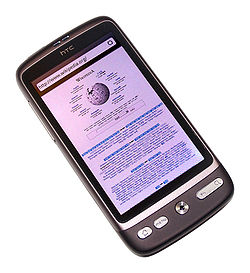
Back إتش تي سي ديزاير Arabic اچتیسی دیزایر AZB HTC Desire Czech HTC Desire Danish HTC Desire German HTC Desire Spanish اچتیسی دیزایر Persian HTC Desire Finnish HTC Desire Italian SoftBank X06HT Japanese
 | |
| Manufacturer | HTC Corporation |
|---|---|
| Type | Smartphone |
| First released | 16 February 2010 |
| Availability by region |
|
| Predecessor | HTC Hero |
| Successor | HTC Desire S |
| Related | HTC Desire Z, HTC Desire HD, HTC Incredible S |
| Compatible networks | Europe/Asia Pacific: HSPA/WCDMA 900/2100 MHz [Model A8181] 850/1900 (Telus Mobility Canada) [Model A8182] 850/2100 MHz (Telstra Australia) [Model A8183] GSM 850/900/1800/1900 MHz |
| Form factor | Slate |
| Dimensions | 119 mm (4.7 in) H 60 mm (2.4 in) W 11.9 mm (0.47 in) D |
| Weight | 135 g (4.8 oz) |
| Operating system | Launched with Android 2.1 "Eclair" Upgradeable to Android 2.3 "Gingerbread"[1] (Though only 2.2 is supported by HTC) |
| CPU | 1 GHz Qualcomm QSD8250 Snapdragon |
| GPU | Adreno 200 |
| Memory | 576 MB RAM |
| Storage | 512 MB flash (150 MB user accessible) |
| Removable storage | microSDHC supports up to 32 GB |
| Battery | 1400 mAh Internal Rechargeable Li-ion User replaceable |
| Rear camera | 5 Megapixel Autofocus LED flash face detection, Geotagging |
| Display | 3.7-inch 480×800 px (0.38 Megapixels) WVGA AMOLED or Super LCD capacitive touchscreen covered by Gorilla Glass[2] |
| Connectivity | Bluetooth 2.1 with EDR Micro USB Wi-Fi 802.11b/g |
| Data inputs | Dual-Touch screen, 3-axis accelerometer, digital compass, proximity and ambient light sensors, FM Radio, compass, A-GPS |
| Codename | Bravo |
| Other | HTC Sense 1.9 interface Flash 10.1 enabled (update to Flash 11 available in Android Market) |
| References | [3] |
The HTC Desire (codenamed Bravo)[4] is the first smartphone of the Desire series developed by HTC. It was announced on 16 February 2010 and released in Europe and Australia in the second quarter of the same year. The HTC Desire was HTC's third flagship phone running Android 2.1 Eclair[5] which can be upgraded to 2.2 Froyo or 2.3 Gingerbread.[6] Internally it bears a strong resemblance to the Nexus One, but differs in some features.
- ^ "HTCdev - HTC Kernel Source Code and Binaries". Archived from the original on 11 May 2012. Retrieved 14 May 2012.
- ^ "Products with Gorilla". Featured products. Corning Incorporated. Archived from the original on 23 October 2011. Retrieved 15 April 2011.
- ^ Ziegler, Chris (16 February 2010). "HTC press conferens MWC 2010". engadget.com. Archived from the original on 18 February 2010. Retrieved 16 February 2010.
- ^ "HTC Bravo becomes HTC Desire". Techdigest. Archived from the original on 2 March 2010. Retrieved 16 February 2010.
- ^ Nield, David. "Path of the One". TechRadar. Archived from the original on 28 March 2014. Retrieved 2 April 2014.
- ^ "HTCdev - HTC Kernel Source Code and Binaries". Archived from the original on 11 May 2012. Retrieved 14 May 2012.